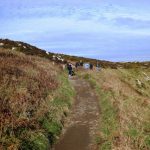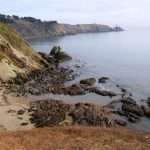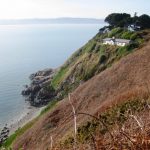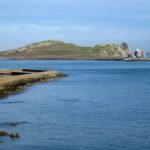
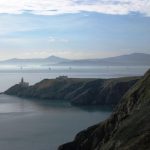
A beautiful late winter’s morning, cold and blue. Outside Howth DART station I met a bunch of friends and relations, all raring to explore the cliff paths of the bulbous peninsula. It was great to have enthusiastic younger folk along for the walk. Sisters Katie (12) and Hannah (10) from the south side of Dublin Bay, fine talkers and walkers, were out to show their English cousins Michael and Elizabeth the cream of the country. At 13 years old, Michael was all for everything; his 16-year-old sister, more of a cat that walks by herself, stalked ahead as outrider for our party.
A twin-masted sailing boat was negotiating the long stag-beetle jaws of Howth Harbour, putting me in mind of the extraordinary events of July 1914 when Erskine Childers sailed into this port in his stout little yacht Asgard with 900 rifles and 25,000 rounds for the use of the Irish Volunteers. The historic yacht’s namesake, the Arklow-built brigantine Asgard II, went down in the Bay of Biscay in September 2008, and now lies full fathom five for ever more – a sad end for a much-loved training vessel.
Before venturing out along the cliffs, we detoured up above the harbour to catch the view around the ruins of Howth Collegiate and Abbey, and to pay our respects to the shade of Father Patrick, legendary teacher at the ecclesiastical college in medieval times. It’s said that French rivals, jealous of the college’s fame and success, came to Howth confident of finding enough evidence of dire teaching to force its closure. But cunning Father Patrick had planted his learned monks around the harbour disguised as working men. The disembarking spies heard fish porters and roadmenders discussing recondite theological matters in Latin, got back on board and sailed away dumbfounded.
Beyond the Martello Tower we passed above the broad curve of Balscadden Bay and were out along the Nose of Howth in no time, with wonderful views to the north over the green sister islands of Ireland’s Eye and Lambay. Cries from the children, scampering ahead on the narrow path, drew my eyes to a seal close inshore, bobbing in the water like a fat bald man in a wetsuit as he watched a fisherman take up his catch. Big dark P&O ferries trod heavily out to sea through a great smeary patch of silver laid along the water by the low winter sun.
The path ran through heather and gorse, a brown ribbon easy to follow. We had a chocolate break sitting on a bench in the sun, where the talk turned to music (Katie and Hannah are both traditional players) and football (Elizabeth and Michael have Chelsea Blue all through them like two sticks of rock). Then it was up and on, with a most tremendous southward view steadily widening over the peninsula’s stumpy white Baily lighthouse, out across the great arc of Dublin Bay where the wind was wrinkling the sea like leviathan hide, to a graceful line of blue mountain peaks twenty miles off in mist-hazed Wicklow.
Past the lighthouse and the exotic sub-tropical gardens of handsome cliff-top residences, we dropped down to Doldrum Bay. The adults lay nibbling and chatting on a knoll, while the three youngest cousins dashed down to the shore and climbed all the sea stacks they could get their hands on. Energy like that, distilled and bottled, could make someone’s fortune.
Now the path struck inland, looping through head-high thickets of gorse on the lower slopes of Shielmartin. I remembered climbing up there on another blowy cold day to find the ring of white quartzite boulders marking the tomb of the warrior king Crimhthan Niadhnair. Assisted by his wife, the goddess Nar of the Brugh, he brought vast plunder back to Ireland from raids against Roman Britain, and buried it … who knows where? Such stories are the very stuff of the land we walk on. Down the hill in Howth Demesne lies a great portal dolmen with a hundred-ton capstone. Some tales say it is a memorial to beautiful Aideen, dead of a broken heart after her beloved husband Oscar fell fighting near Tara. Or is it a quoit thrown here from the Bog of Allen by the mighty arm of Fionn MacCumhaill?
Back in Howth, I considered taking the children on to see the dolmen; then looked at their faces, a little tired now, and thought better of it. Chips and ice-cream were on their minds now. You’d better not argue with those.
Irish Independent – WALK OF THE WEEK – Christopher Somerville
14 March 2009
WAY TO GO
MAP: OS of Ireland 1:50,000 Discovery 50; downloadable map/instructions at www.discoverireland.ie/walking.
TRAVEL:
Rail: DART to Howth
Road: M50 to Jct 3, N32, on to Howth.
WALK DIRECTIONS (waymarked with purple arrows): From DART station, left along Howth Harbour (detour right up Abbey Street to Collegiate ruin, then right again up Church Street for Howth Abbey). Continue along harbour, then follow purple arrows for 4 miles along cliffs, past Baily Lighthouse and on past Doldrum Bay. Just short of Martello Tower, bear right inland (purple arrows) to cross Carrickbrack Road. Follow purple arrows through gorse, over golf course (white stone path markers) and on through Bog of Frogs. Bear left downhill through Balkill Park estate to Howth DART station. (Detour: left along road for 400 m to find gates to Howth Castle, Howth Demesne and Aideen’s Grave.)
LENGTH: 6½ miles: allow 3 hours
GRADE: Easy/moderate
CONDITIONS: Some muddy patches between Baily lighthouse and Doldrum Bay; otherwise fair underfoot.
DON’T MISS … !
• Howth Collegiate and Abbey
• View from eastern cliffs over lighthouse, Dublin Bay and Wicklow Hills
• Beaches around Doldrum Bay for picnics and a scamper
REFRESHMENTS:
Abbey Tavern, Abbey Road, Howth (tel 01-839-0307; www.abbeytavern.ie) – fires, comfort, good bar food.
La Cucina, Harbour Road (01-832-4443; www.wrightsfindlaterhowth.com) – family friendly place
ACCOMMODATION: Clontarf Castle, Castle Avenue, Clontarf, Dublin 3 (tel 01-833-2321; www.clontarfcastle.ie) – from €220 dble B&B plus dinner.
INFORMATION: Details of local walking tour operators, plus dozens of local walks including Discover Ireland’s ‘National Loop Walks’ and walking festivals throughout the country: www.discoverireland.ie/walking
Tourist Information: www.visitdublin.com
